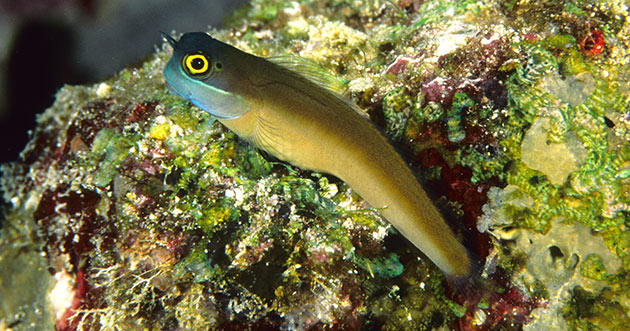
The Ecsenius spp. make fascinating aquarium inhabitants. The colorful livery that many display, as well as their interesting behavior, makes them my favorites in the blenny clan. Even so, relatively few are common in the aquarium trade. Because of their small size, they can be kept in small or large aquariums. They can be kept in a nano-reef setting, but they may suffer from malnutrition in a smaller aquarium environment because there is likely to be less algae present for them to feed on than in a larger aquarium (if this is the case, the aquarist must make sure to aggressively supplement their diet).
When keeping Clown Blennies in the home aquarium, it is essential to provide them with plenty of hiding places. Members of this genus prefer tight spaces, like the calcareous tubes of serpulid worms, larger snail shells, or holes in the live rock. You can use an electric drill and a masonry bit to create appropriate-sized hiding places in the live rock. Depending on the size of the Blenny, holes that are approximately 0.5 to 1.0 cm in diameter are perfect for these fishes.
It is important that these Blennies are fed vegetable matter, like frozen foods that contain the blue-green algae, Spirulina. They typically will not thrive unless some microalgae (e.g., diatoms and unicellular green algae) is present in the aquarium. For this reason, it is a good idea to let microalgae grow on the sides and back of the aquarium to provide them with a constant food supply. The amount of supplemental feeding will be based in part on the amount of natural food present. If lots of algae is available in the aquarium, feed once a day. If plant matter is in short supply, feed them at least three times a day. Keep a close eye on the Blenny’s girth and if your Ecsenius appears to be losing weight, feed it more. The Midas (Ecsenius midas) and Tailspot Blenny (E. stigmatura) spend much of their time swimming in the water column feeding on zooplankton. These two species should be fed a couple of time a day to ensure their nutritional needs are met (E. stigmatura will feed on algae as well).
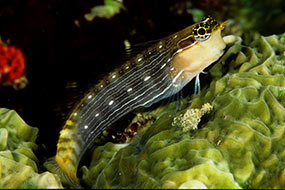
Escenius pictus |
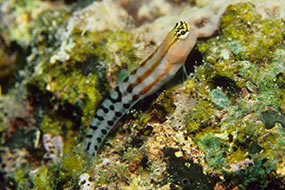
Escenius fijiensis |
While the Ecsenius spp. are not normally highly belligerent, they may respond aggressively toward other Blennies or small, benthic fishes that invade their territories. Conspecifics will fight if crowded (males are most likely to quarrel). While in nature, subordinate individuals simply avoid more aggressive conspecifics, in the aquarium it can be difficult if space is limited. A Clown Blenny that is being picked on will typically end up hiding in the upper corners of the aquarium or under the reef décor. A dominant Ecsenius may preclude a subordinate from preferred hiding places and may also prevent it from getting enough to eat. If you have two quarreling Ecsenius spp., it is prudent to remove one of the combatants. If the aquarium is large enough (e.g., 135 gallon), it is possible to keep more than one Ecsenius (even two males) in the same setup (make sure there are plenty of suitable hiding places that are situated at each end of the aquarium).
There are some species in the genus that regularly occur in small groups in the wild (e.g., Ecsenius lividanalis E. ops, and E. tricolor) and may be kept in a similar social unit in the home aquarium. All individuals should be placed in the aquarium simultaneously and if persistent fighting occurs, sparing individuals may have to be separated. If you want to keep more than one Ecsenius in the same setup, your best bet is to house a male and female together. But how do you tell the sexes apart? There are a couple of ways to increase the odds of getting a male and a female. First of all, males tend to be larger than females (this has been shown in at least some members of this genus and is thought to be true for most). Therefore, selecting two conspecifics that differ significantly in size could increase the likelihood that you will acquire a heterosexual pair. The second way is to select two smaller conspecifics. If they have yet to sexually mature, one is likely to become a female, while the other may transform into a male (that is, if initial observations prove to be true and these are protogynous hermaphrodites).
While the Clown Blennies typically do not go out of their way to chastise heterospecific fish tankmates, there are occasions when they may behave aggressively toward small fishes that invade their territories. For example, I have seen adult bicolor blennies pick on tiny Gobies, Firefishes, and Dart Gobies that moved too close and have had this same species fight for a favorite hole with small Dottybacks, and a Royal Gramma. They usually chase or display at intruders, but if the interloper does not “get the message,” they may end-up nipping the other fish. They may even bite the fins of larger herbivores that pass through their territories. Clown Blenny aggression rarely results in serious injury unless the aquarium is so small that the other fish cannot avoid the Ecsenius sp.
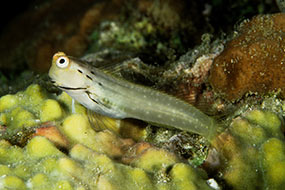
Escenius stictus |
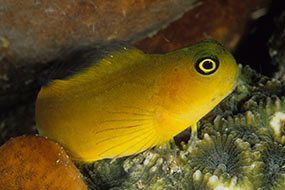
Escenius lividanalis |
It is more common that Clown Blennies are recipients of aggressive behavior often the target of specific tankmates. They are most likely to be harassed by other benthic reef-dwellers, like Dottybacks, Hawkfishes, and larger Blennies (e.g., Atrosalarias, Cirripectes and Salarias spp.). Clown Blennies that were incessantly chased have been known to jump completely out of the aquarium or leap into the overflow box. They are also likely to hide incessantly and stop feeding.
The Clown Blennies are typically wonderful reef aquarium fishes. You should be aware that some individuals will nip at corals and clam mantles. There are two species, the Bicolor Blenny (Ecsenius bicolor) and the Red Sea Mimic Blenny (E. gravieri), that have been implicated in feeding on small-polyped stony corals, although this is not a common occurrence. There are also species that will rasp slime off of large-polyped stony corals, which can cause the polyps to retract. This undesirable feeding behavior is more likely to occur if suitable algae is in short supply and they are not fed enough.
The Clown Blennies can live for at least 6 years in the home aquarium. They lack scales, which may lead you to conclude that they are more susceptible to parasitic infection. But the Ecsenius spp. are fairly disease resistant. This may be due to the fact that they protect themselves by producing excessive amounts of slime. When they are stressed (or at night) many adopt a more subdued color pattern that includes lines or bands on the body.
Part 1:
Introduction |
| |
Part 2:
The Natural History of Clown Blennies |
| |
Part 3:
Keeping Clown Blennies in the Home Aquarium |

Scott Michael
Scott W. Michael is an internationally-recognized writer, underwater photographer, and marine biology researcher specializing in reef fishes, and was the Banquet Speaker at our 2007 and 2008 Coral Conference and Frag Swap. He is a regular contributor to Aquarium Fish Magazine, Freshwater and Marine Aquarium Magazine, SeaScope, and is the author of Reef Fishes Vol 1, Vol 2, and Vol 3, Vol 4, and Vol 5., A Pocket Expert Guide Marine Fishes, A Pocket Expert Guide to Reef Aquarium Fishes, 101 Best Saltwater Fishes: How to Choose and Keep Hardy, Brilliant, Fascinating Species That Will Thrive in Your Home Aquarium, Reef Sharks & Rays of the World, and Aquarium Sharks & Rays. Having studied marine biology at the University of Nebraska, Scott has served as a scientific consultant for National Geographic Explorer, the Discovery Channel, and French educational television.
|